Investigation of the Structural Strength of Expansive Soil in a Seasonally Frozen Region
Abstract
1. Introduction
2. Materials and Methods
2.1. Study Area
2.2. Soil Properties
2.3. Sample Preparation
2.4. USC Test
2.5. High-Pressure Consolidation Test
2.6. SEM
3. Results
3.1. Results of UCS Tests
3.1.1. Failure State
3.1.2. Stress–Strain Curve
3.1.3. Parameters of Strength
3.2. Results of High-Pressure Consolidation Test
3.2.1. Curve
3.2.2. Elastic and Residual Deformation
3.2.3. Structural Yield Stress
4. Discussion
4.1. Microstructure of Undisturbed and Remolded Expansive Soil
4.2. Influencing Factors of Structural Expression
5. Conclusions
- (1)
- The undisturbed samples have structural strength due to a better structural connection and particle arrangement than those of the remolded samples. The structural strength of undisturbed expansive soil is mainly expressed in the stronger structural connection in the initial stage of unconfined compression, the better resistance to deformation in the later stage of unconfined compression, and the superior ability to withstand vertical load under confined compression.
- (2)
- Under unconfined compression, the samples display various failure states due to differences in water content and density. Type I undisturbed samples are broken along multiple vertical penetration fractures, Type II undisturbed samples are destroyed along a shear surface, Type III undisturbed samples do not show shear damage, and remolded samples all show bulging damage.
- (3)
- Under unconfined compression, the deterioration of primary fractures is stronger than the structural strength. Thus, the qu values of the undisturbed samples of Types I and II are lower than those of the remolded samples. With the increase in water content and the decrease in density, the expression degree of structural strength in terms of compressive strength and resistance to deformation rises.
- (4)
- Under confined compression, the structure strength is more highly expressed due to the suppression of the development of primary fractures. Therefore, the Cc and e2 values of the undisturbed samples are smaller, and the structural yield stress is greater. With the increase in water content and the decrease in density, the expression degree of structural strength in terms of strength ascends, but the resistance to compressive deformation declines.
- (5)
- Internal factors (basic property, particle composition, and structural linkage) and external factors (lateral confinement and historical role) all affect the expression of structural strength. For the basic property, water content mainly determines strength (qu, σk), and density predominantly affects resistance to deformation (ɛu, Cc). Particle composition and structural linkage affect the microstructure of the soil. Lateral confinement and historical role primarily affect the formation and development of fractures and, consequently, the expression of structural strength.
- (6)
- The soils in a seasonally frozen region undergo periodic freeze–thaw cycles, which can also impact the expression of structure. In future work, freeze–thaw cycle tests can be conducted on undisturbed and remolded samples to provide a better discussion on the structure of expansive soils.
Author Contributions
Funding
Data Availability Statement
Acknowledgments
Conflicts of Interest
References
- Wang, Q.; Kong, Y.Y.; Zhang, X.D.; Ruan, Y.K.; Chen, Y. Mechanical effect of pre-consolidation pressure of structural behavior soil. J. Southwest Jiaotong Univ. 2016, 51, 987–994. [Google Scholar]
- Peng, W. Analysis of Quantitative Structural Parameters and Elastoplastic Constitutive Model of Saline Soil under Freeze-Thaw Cycle. Ph.D. Thesis, Jilin University, Changchun, China, 2022. [Google Scholar]
- Zhang, Y.Z.; Pu, S.Y.; Li, R.Y.M.; Zhang, J. Microscopic and mechanical properties of undistributed and remoulded red clay from Guiyang, China. Sci. Rep. 2020, 10, 18003. [Google Scholar] [CrossRef]
- Zhen, Z.L.; Ma, G.L.; Zhang, H.Y.; Gai, Y.X.; Su, Z.Y. Thermal Conductivities of Remolded and Undisturbed Loess. J. Mater. Civ. Eng. 2019, 31, 04018379. [Google Scholar] [CrossRef]
- GB/T 50123-2019; Standard for Soil Test Methods. China Planning Press: Beijing, China, 2019.
- Jiang, M.J.; Zhang, F.G.; Hu, H.J.; Cui, Y.J.; Peng, J.B. Structural characterization of natural loess and remolded loess under triaxial tests. Eng. Geol. 2014, 181, 249–260. [Google Scholar] [CrossRef]
- Yuan, Z.H. Research on Change Mechanism of Strength and Microstructure of Loess under Wetting-Drying Cycle. Ph.D. Thesis, Chang’an University, Xi’an, China, 2015. [Google Scholar]
- Zhang, S.; Liang, C.; Zheng, C.; Zhai, J.Y. Comparative study on triaxial test of undisturbed and remolded loess. Math. Probl. Eng. 2022, 2022, 6392909. [Google Scholar] [CrossRef]
- Ma, L. A Study on Constitutive Model and Tests on Influence of Free Ferric Oxide on Increasing of Strengh of Granite Residual Red Soil. Ph.D. Thesis, Jilin University, Changchun, China, 2007. [Google Scholar]
- Kong, Y.Y. Experimental Research on the Saline Soil Water-Salt Transport and Structure Evolution in Zhenlai Zone. Ph.D. Thesis, Jilin University, Changchun, China, 2017. [Google Scholar]
- Sarker, D.; Wang, J.X. Moisture influence on structural responses of pavement on expansive soils. Transp. Geotech. 2022, 35, 100773. [Google Scholar] [CrossRef]
- Muhammed, T.; Volkan, E.; Islam, G. Utilization of waste materials in the stabilization of expansive pavement subgrade: An extensive review. Constr. Build. Mater. 2023, 398, 132435. [Google Scholar]
- Shi, B.X.; Zhang, C.F.; Wu, J.K. Research progress on expansive soil cracks under changing environment. Sci. World J. 2014, 2014, 816759. [Google Scholar] [CrossRef] [PubMed][Green Version]
- Yang, Z.N.; Lu, Z.C.; Shi, W.; Wang, C.; Ling, X.Z.; Liu, X.; Guan, D.; Cheng, Z.J. Dynamic Properties of Expansive Soil-Rubber under Freeze-Thaw Cycles. J. Mater. Civil Eng. 2023, 35, 04023026. [Google Scholar] [CrossRef]
- Zhang, Q.; Xia, Y.J.; Zhao, J.C.; Tang, C.; Zhang, B. Experimental investigation of crack evolution in expansive soil-rubber mixture (ESR) under freeze-thaw cycles. Cold Reg. Sci. Technol. 2024, 217, 104016. [Google Scholar] [CrossRef]
- Wang, Q.; Liu, Y.F.; Liu, S.W.; Zhang, X.D.; Peng, W.; Li, C.Y.; Xu, X.C.; Fan, J.H. Evolution law of the properties of saline soil in western Jilin province under multi field effect. J. Jilin Univ. (Earth Sci. Ed.) 2017, 47, 807–817. [Google Scholar]
- Hu, X.H.; Zhang, K.Y.; Nie, M.J.; Pan, R.Y. Effect of experimental conditions on strength indexes of expansive soil during wet-dry cycles. J. Central South Univ. (Earth Sci. Ed.) 2022, 53, 269–279. [Google Scholar]
- Ye, W.J.; Chen, Y.Q.; Gao, C.; Xie, T.F.; Jing, H.J.; Deng, Y.S. Experimental study on the microstructure and expansion charac-teristics of paleosol based on spectral scanning. J. Spectrosc. 2021, 2021, 6689073. [Google Scholar] [CrossRef]
- Jiang, P.F.; Kong, Y.Y.; Song, Z.Y.; Zhao, R.X.; Zhan, J.W.; Liu, X.H. Development characteristics and sensitivity analysis of expansive soil slope. Geofluids 2022, 2022, 4303911. [Google Scholar] [CrossRef]
- Liu, G.S.; Zhao, S.D.; Mou, Z.; Mo, K.Y.; Zhao, Q.S. Experimental study of the influence of structure on the shrinkage charac-teristics of expansive soil. Rock Soil Mech. 2022, 43, 1772–1780. [Google Scholar]
- Gaspar, T.A.V.; Jacobsz, S.W.; Heymann, G.; Toll, D.G.; Gens, A.; Osman, A.S. The mechanical properties of a high plasticity expansive clay. Eng. Geol. 2022, 303, 106647. [Google Scholar] [CrossRef]
- Pan, B.Y. Study on Expansive Soil in Drying-Watering Cycle and Constitutive Models Considering over Consolidation and Structure. Master’s Thesis, Guangxi University, Nanning, China, 2014. [Google Scholar]
- Li, T.G.; Kong, L.W.; Wang, J.T.; Wang, F.H. Trimodal pore structure evolution characteristics and mechanical effects of expansive soil in seasonally frozen areas based on NMR test. Rock Soil Mech. 2021, 42, 2741–2754. [Google Scholar]
- Karunarathne, A.M.A.N.; Gad, E.F.; Rajeev, P. Effect of insitu moisture content in shrink-swell index. Geotech. Geol. Eng. 2020, 38, 6385–6392. [Google Scholar] [CrossRef]
- GB 50112-2013; Technical Code for Buildings in Expansive Soil Regions. China Architecture & Building Press: Beijing, China, 2013.
- Li, J.H.; Zhang, L.M. Study of desiccation crack initiation and development at ground surface. Eng. Geol. 2011, 123, 347–358. [Google Scholar] [CrossRef]
- Pei, P.; Zhao, Y.L.; Ni, P.P. A protective measure for expansive soil slopes based on moisture content control. Eng. Geol. 2020, 269, 105527. [Google Scholar] [CrossRef]
- Yu, Q.B.; Wang, Q.; Li, X.H.; Yao, M.; Sun, X.; Xia, W.T.; Shu, H.; Liu, J.; Wang, Z.X. Dynamic characteristics and concept expression of soil structure. J. Eng. Geol. 2022, 30, 1914–1928. [Google Scholar]
- Ferreira, S.R.D.M.; Araújo, A.G.D.D.; Barbosa, F.A.S.; Silva, T.C.R.; Bezerra, M.L. Analysis of changes in volume and propagation of cracks in expansive soil due to changes in water content. Rev. Bras. Ciênc. Solo. 2020, 44, e0190169. [Google Scholar] [CrossRef]
- Tang, D.X.; Liu, Y.R.; Zhang, W.S.; Wang, Q. Rock and Soil Engineering, 2nd ed.; Geology Press: Beijing, China, 1999. [Google Scholar]
- Lin, B.T.; Cerato, A.B. Applications of SEM and ESEM in microstructural investigation of shale-weathered expansive soils along swelling-shrinkage cycles. Eng. Geol. 2014, 177, 66–74. [Google Scholar] [CrossRef]
- Wang, W.W.; Wang, R.; Zang, M.; Zhang, C.C.; Yi, Y. Experimental research on three-dimensional space distribution characteristics of the expansive soil cracks. Sci. Technol. Eng. 2017, 17, 245–251. [Google Scholar]
- Bao, S.C.; Wang, Q.; Bao, X.H. Study on dispersive influencing factors of dispersive soil in western Jilin based on grey correlation degree method. Appl. Mech. Mater. 2013, 291–294, 1096–1100. [Google Scholar] [CrossRef]
- Zhang, J.H.; Zhang, A.S.; LI, J.; Li, F.; Peng, J.H. Gray correlation analysis and prediction on permanent deformation of subgrade filled with construction and demolition materials. Materials 2019, 12, 3035. [Google Scholar] [CrossRef] [PubMed]
- Cai, Z.Y.; Zhu, X.; Huang, Y.H.; Zhang, C. Influences of freeze-thaw process on evolution characteristics of fissures in expansive soils. Rock Soil Mech. 2019, 40, 4555–4563. [Google Scholar]
- Huang, Z.; Zhang, H.; Liu, B.; Wei, B.X.; Wang, H. Using CT to test the damage characteristics of the internal structure of expansive soil induced by dry-wet cycles. AIP Adv. 2021, 11, 075305. [Google Scholar] [CrossRef]
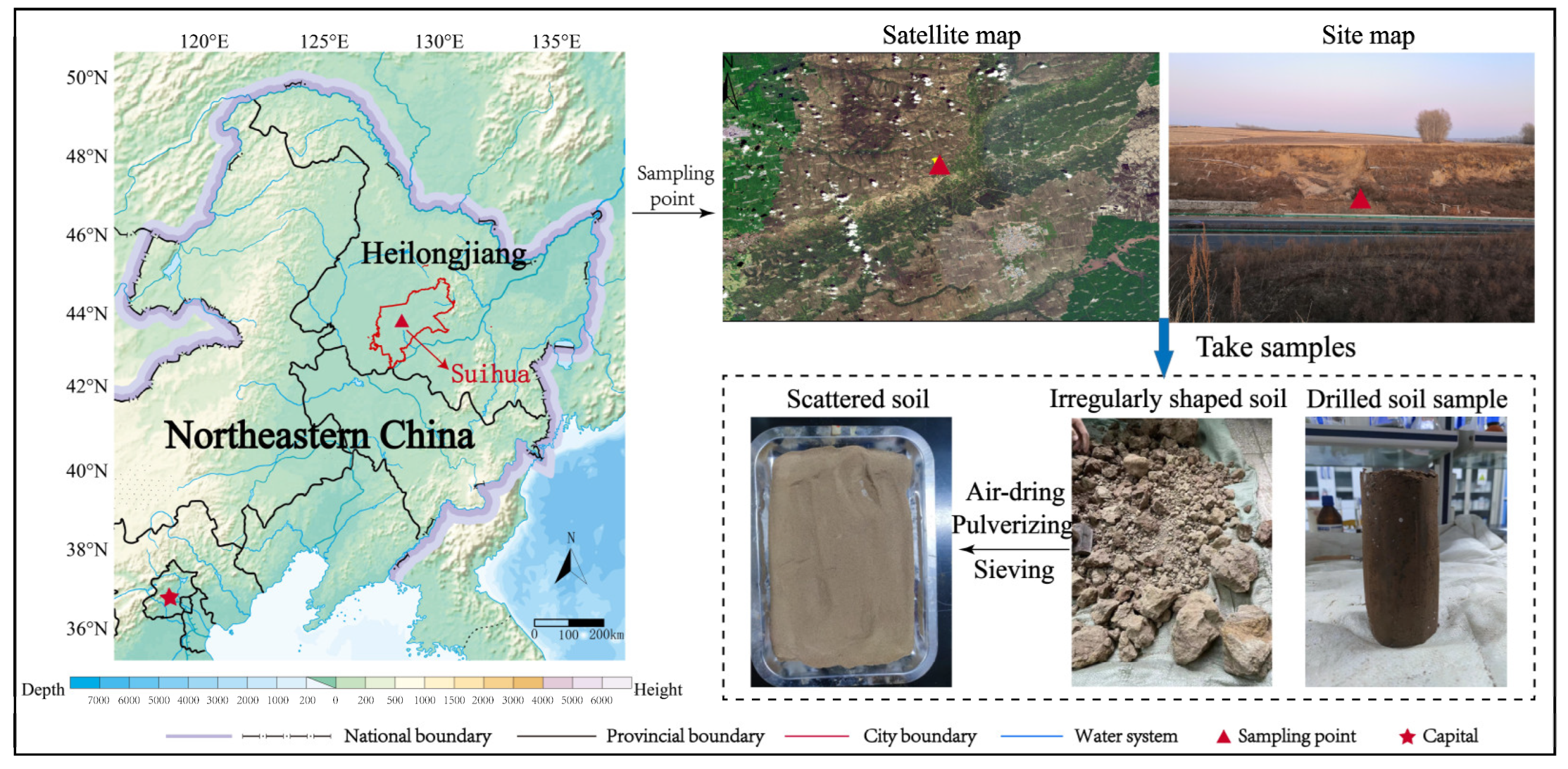
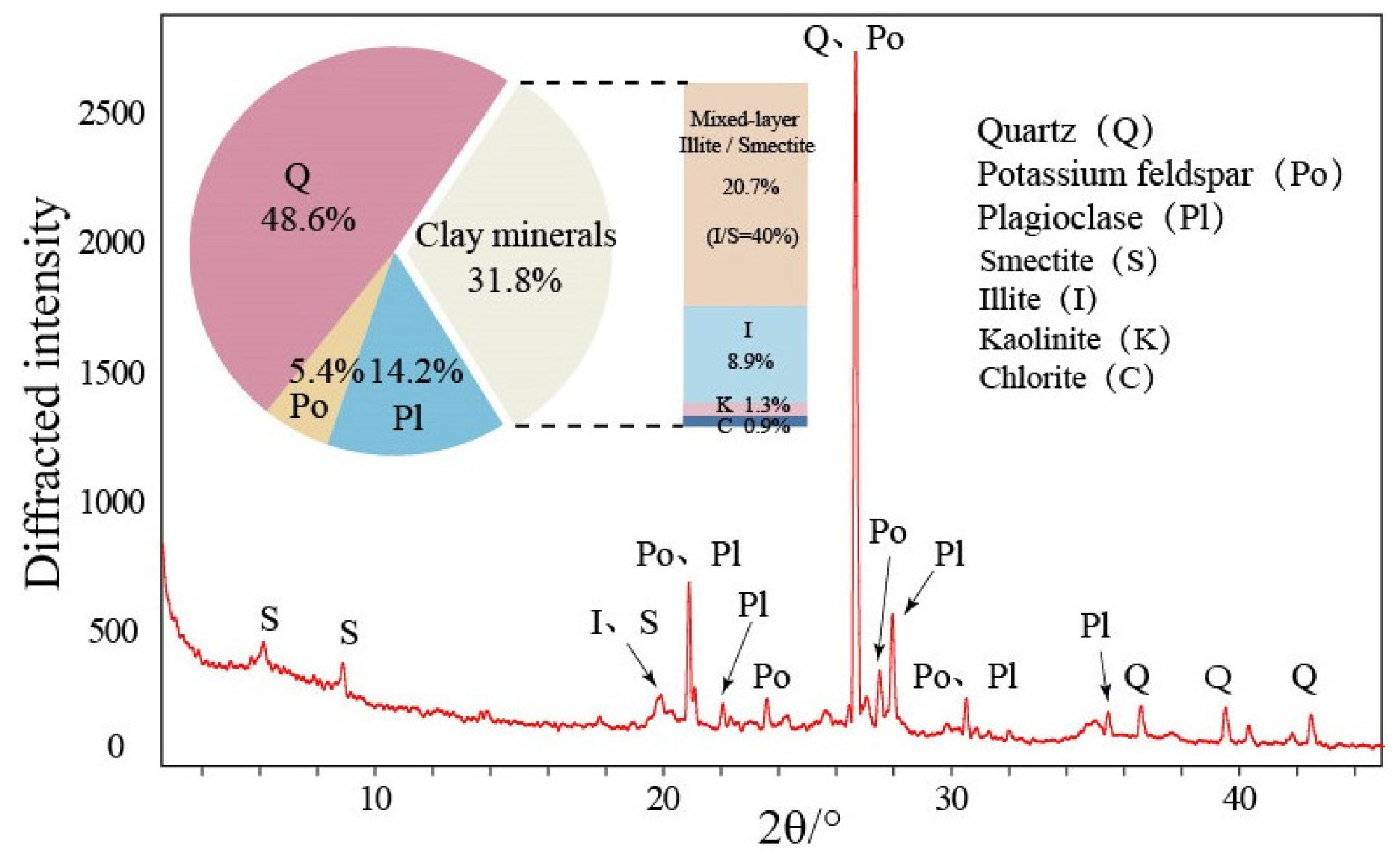
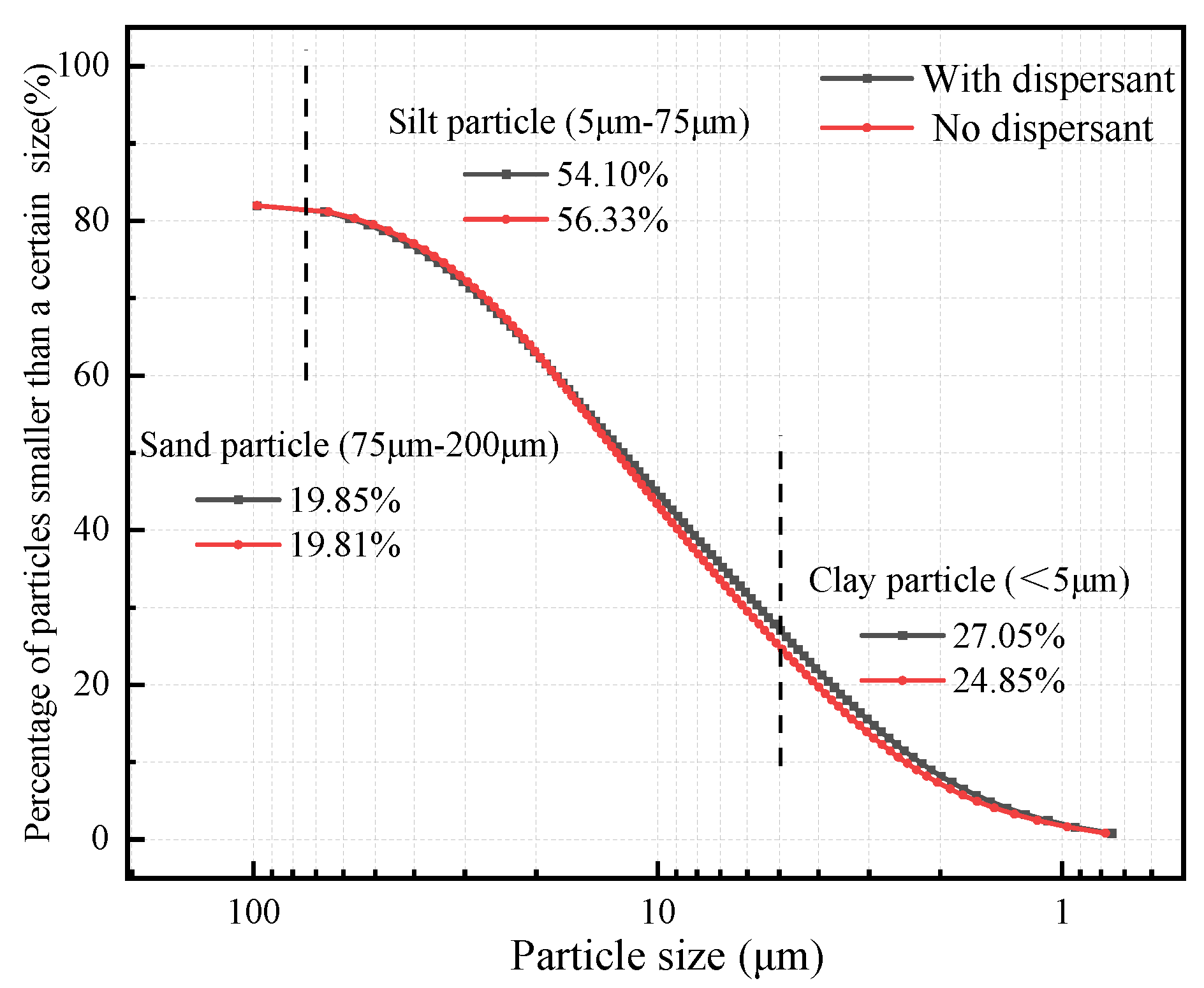

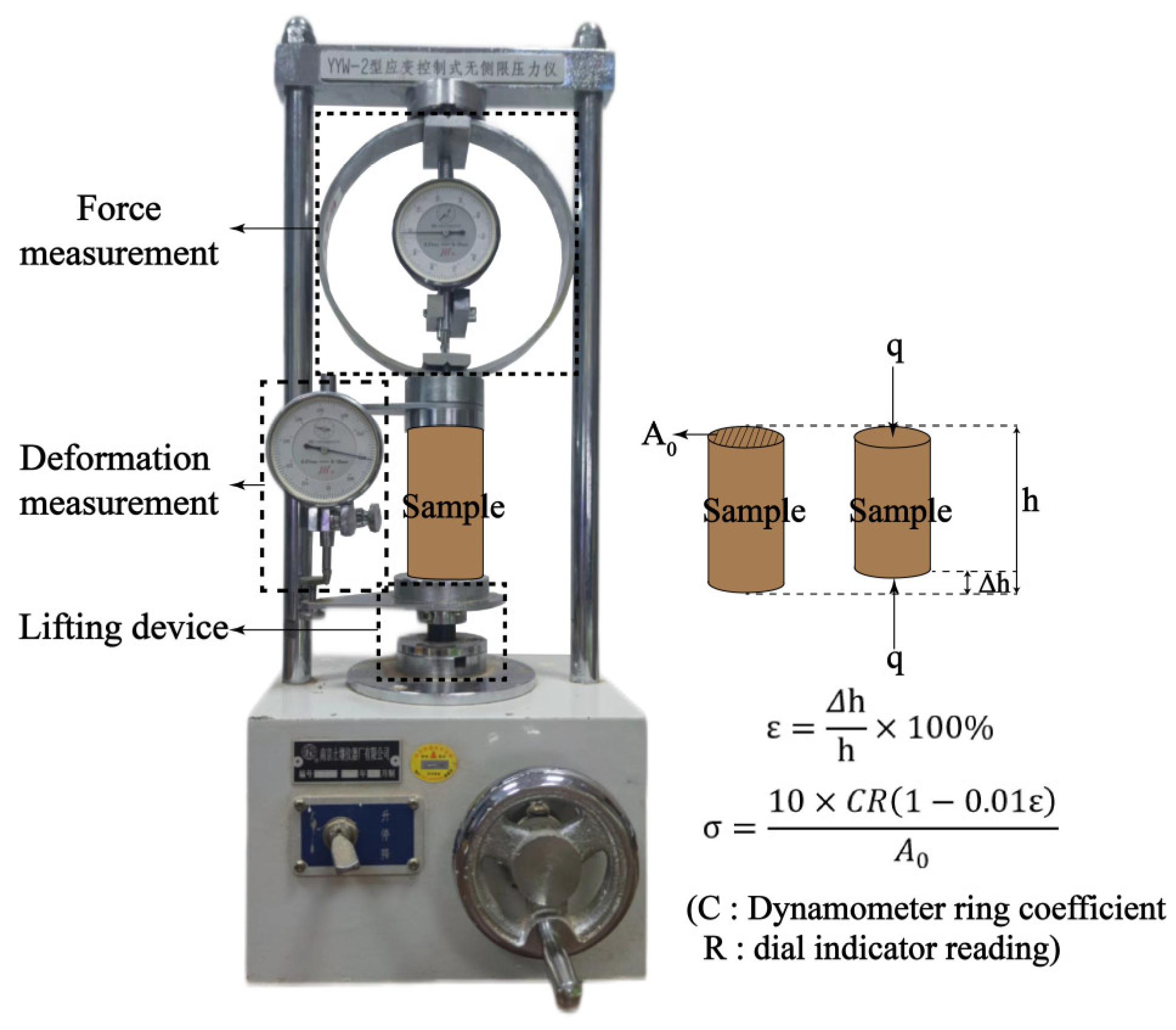
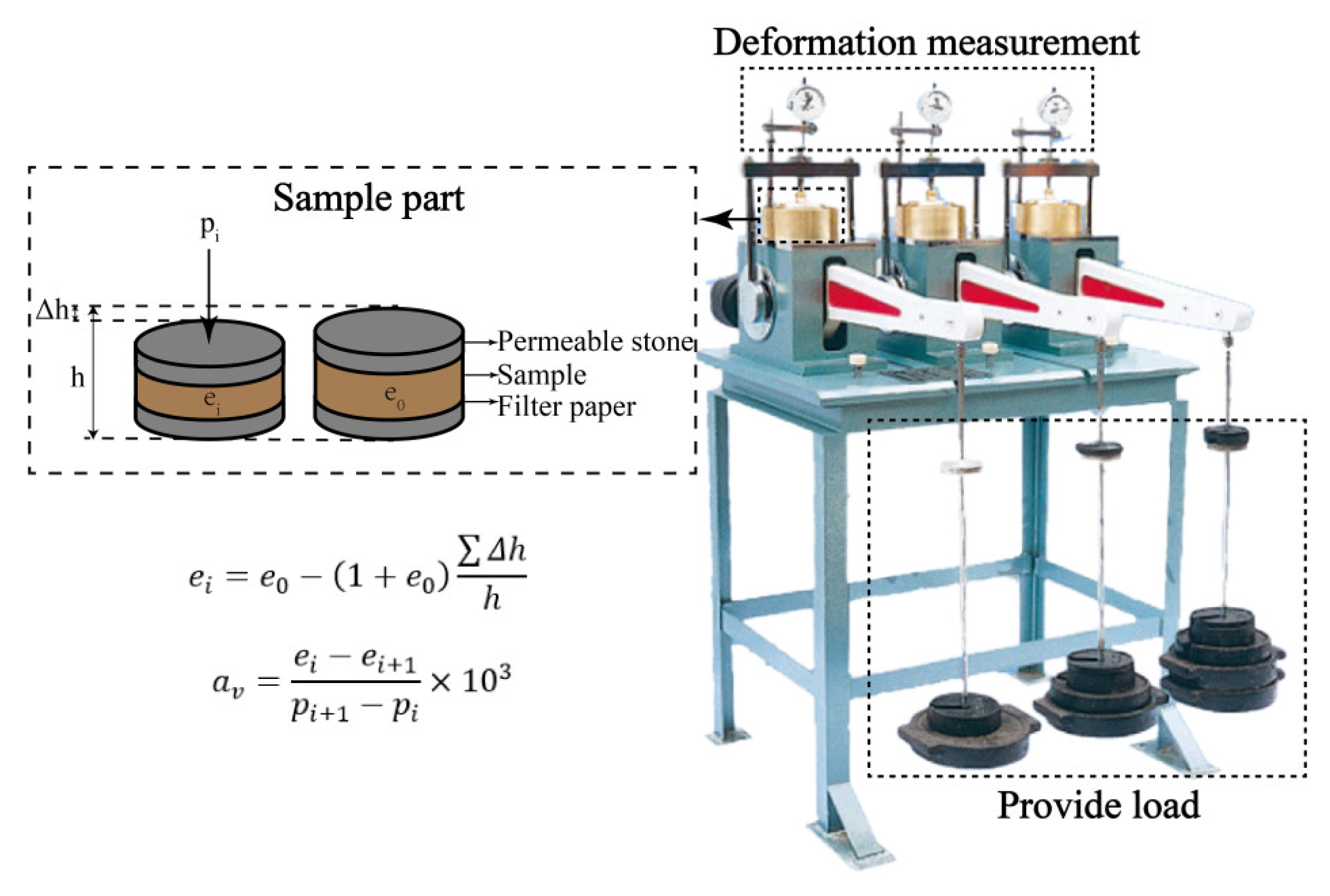
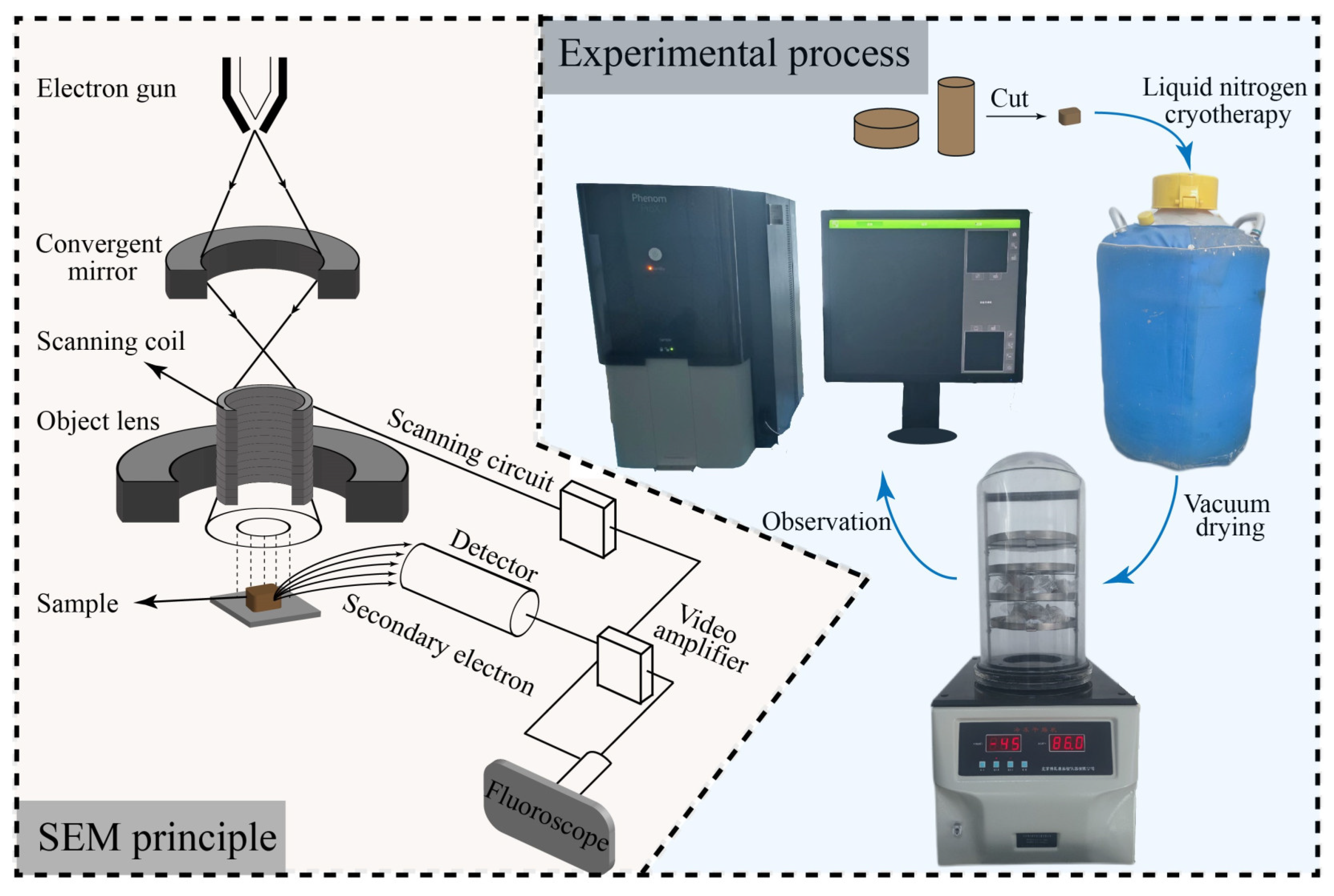
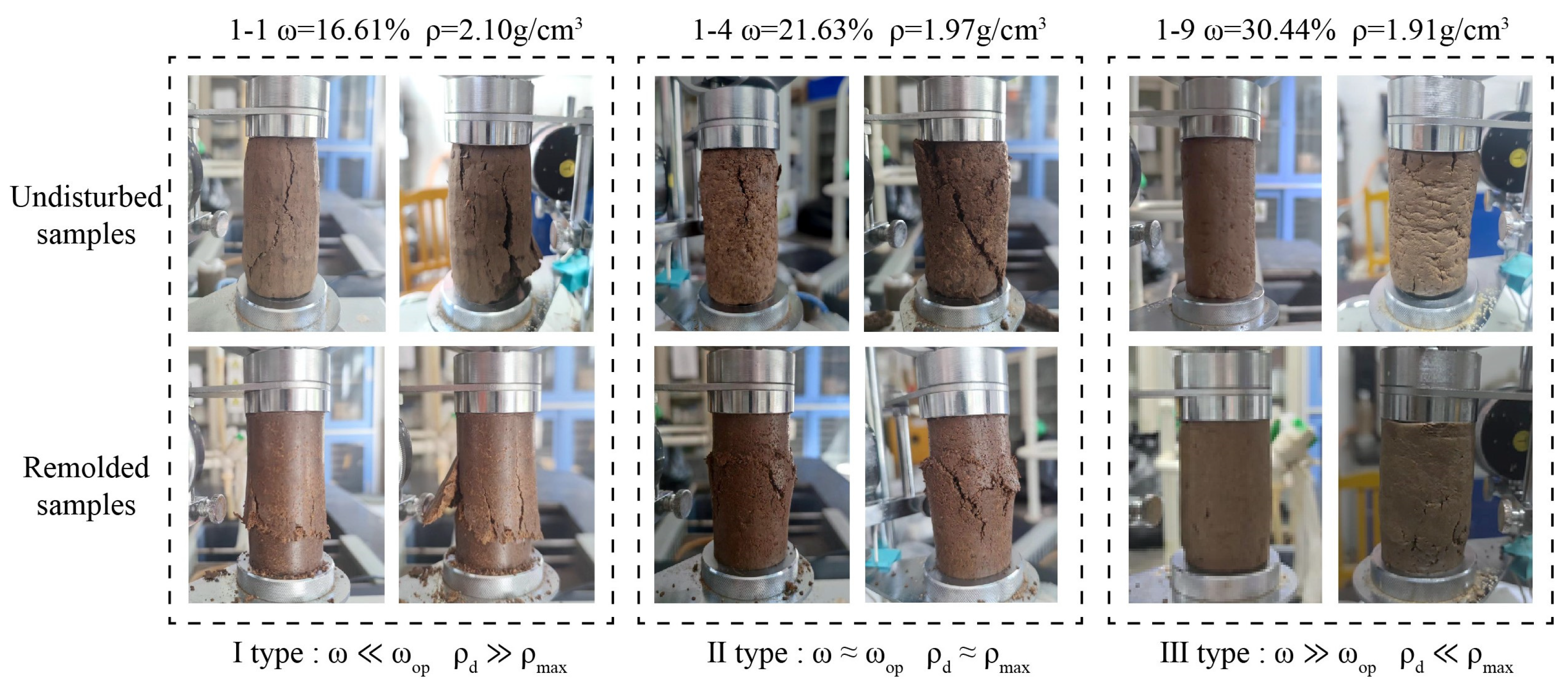
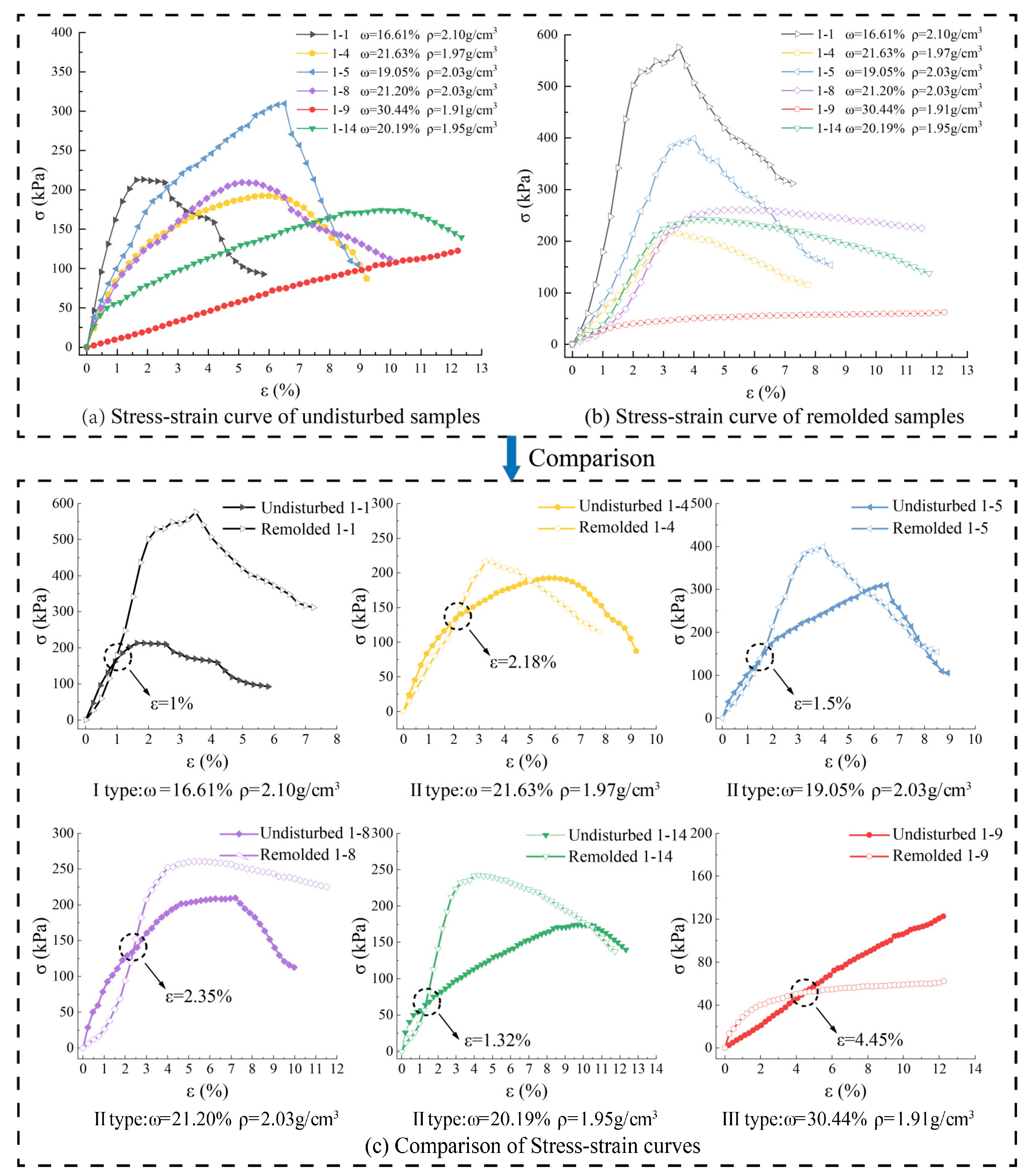
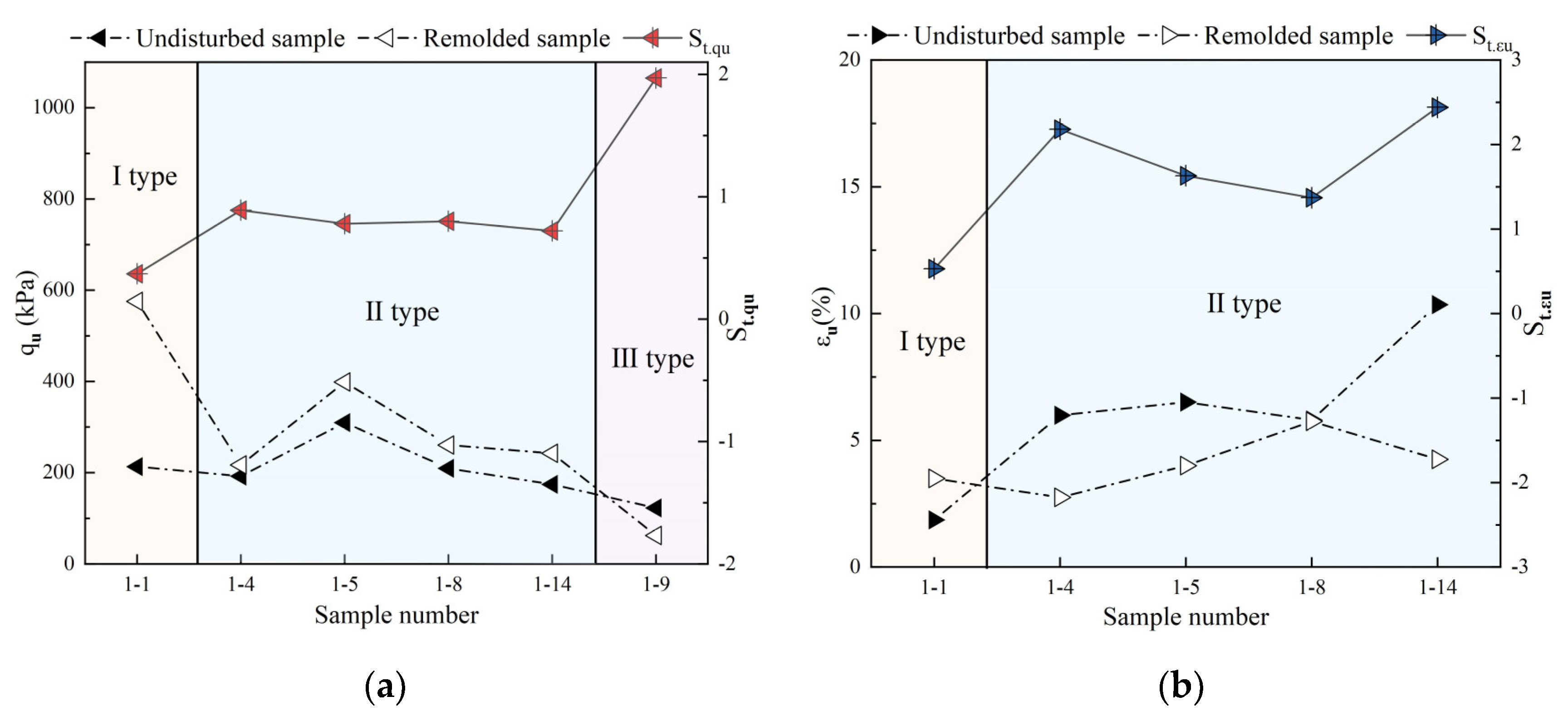
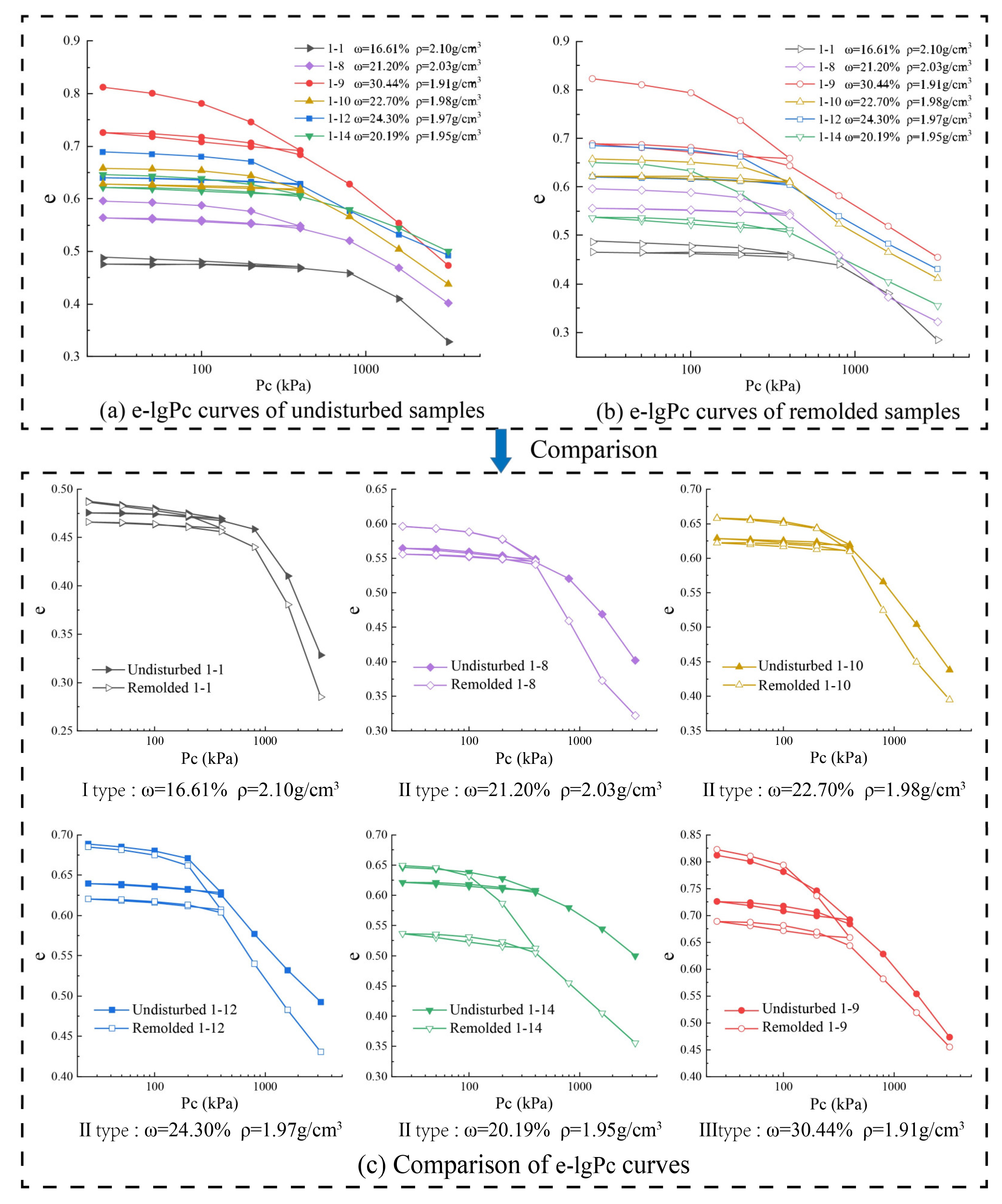
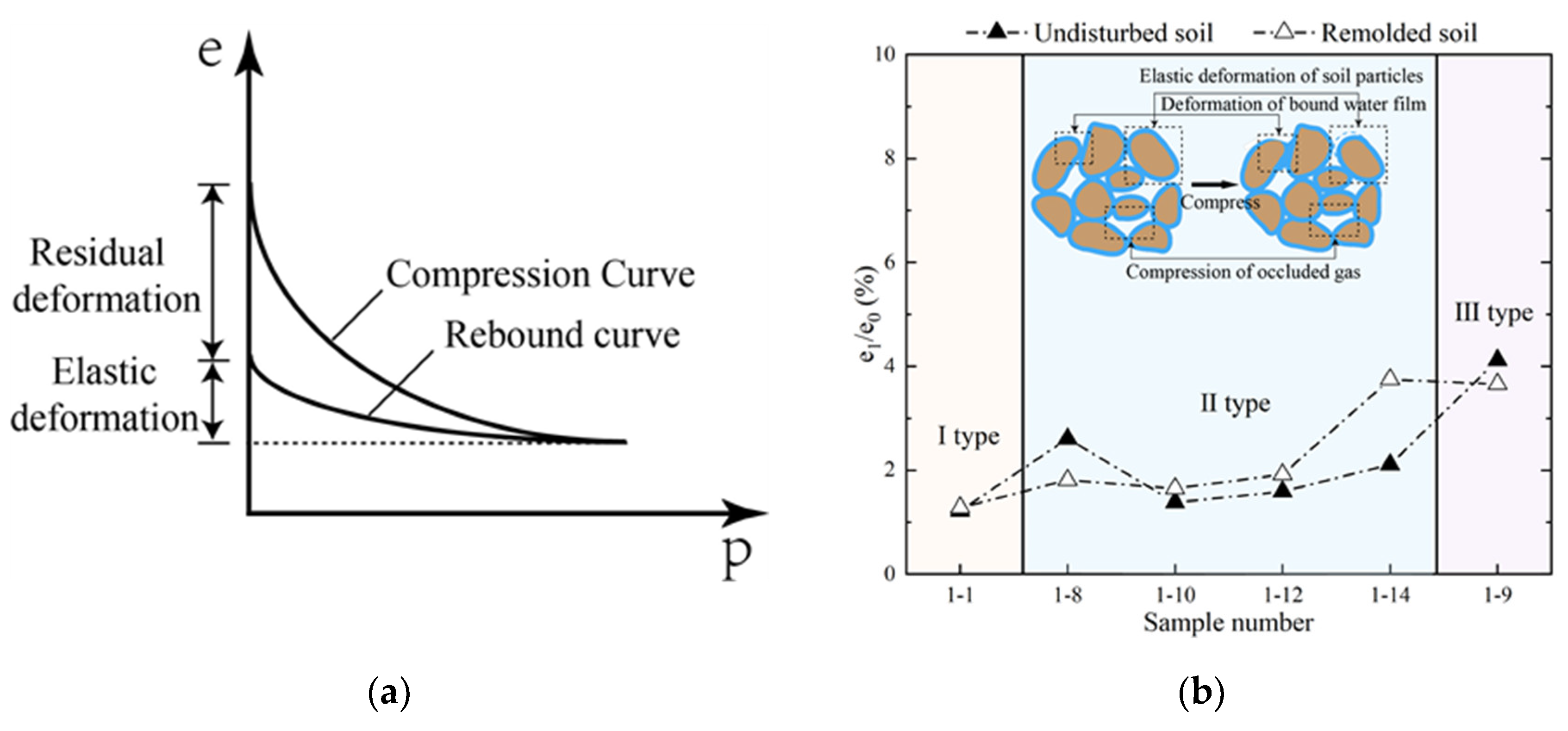
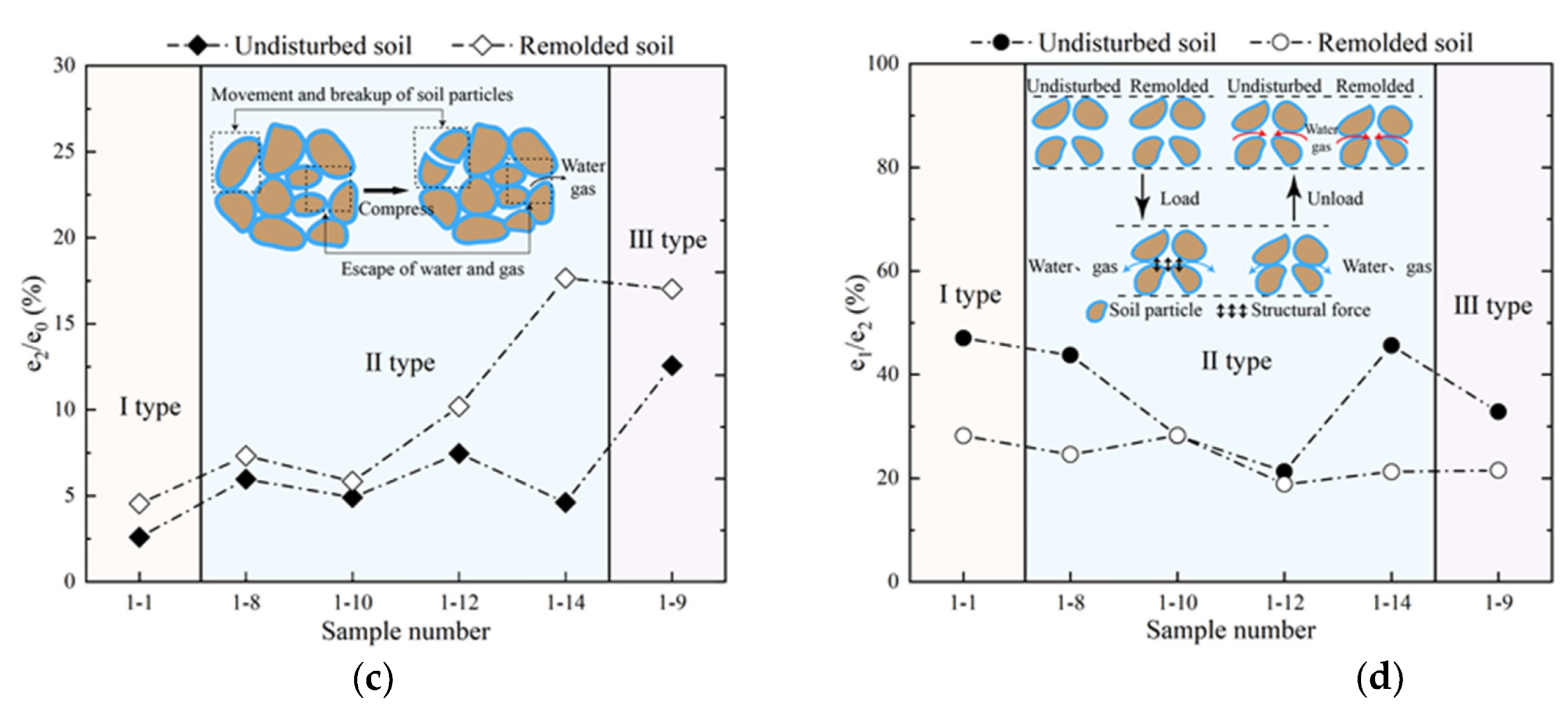
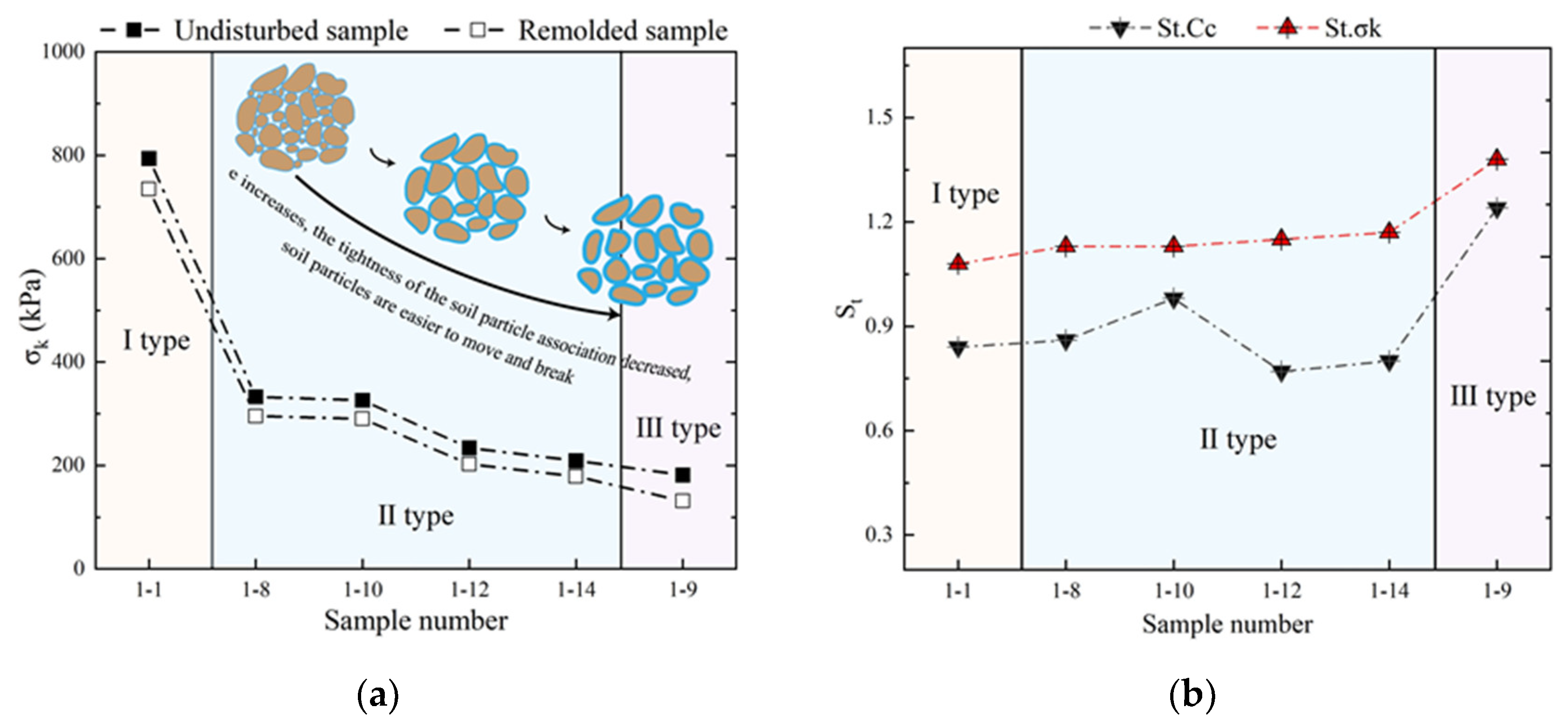

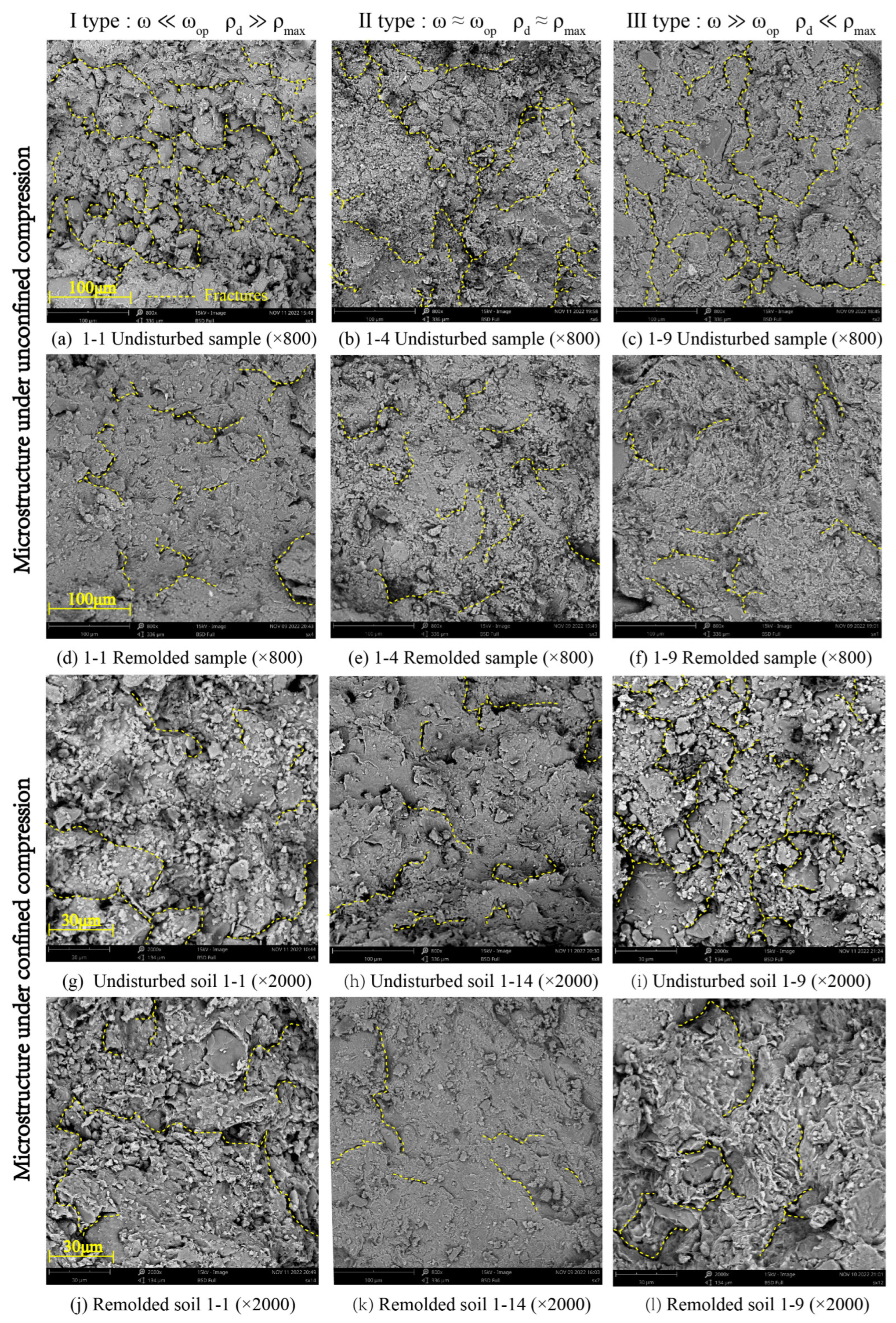
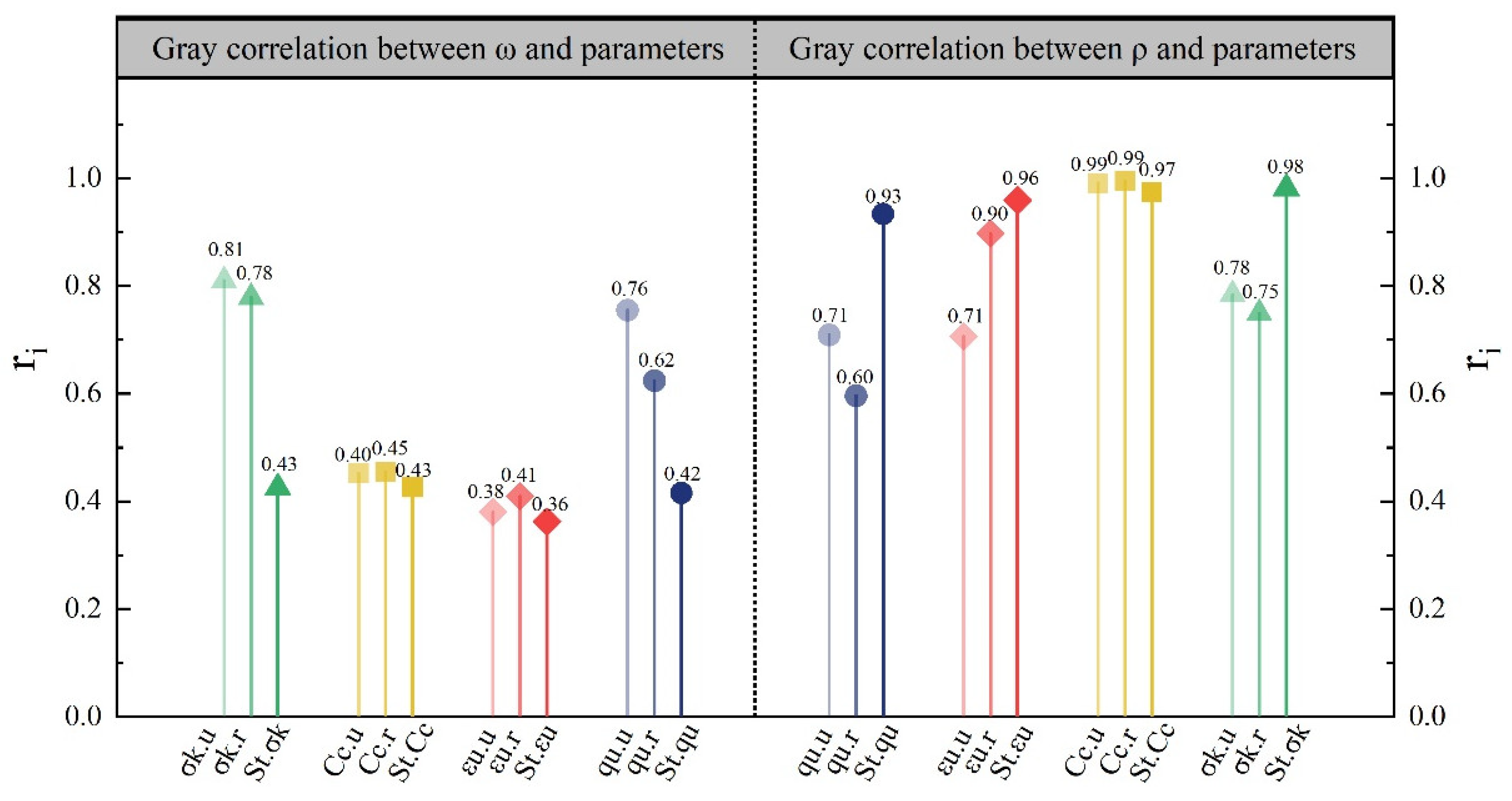
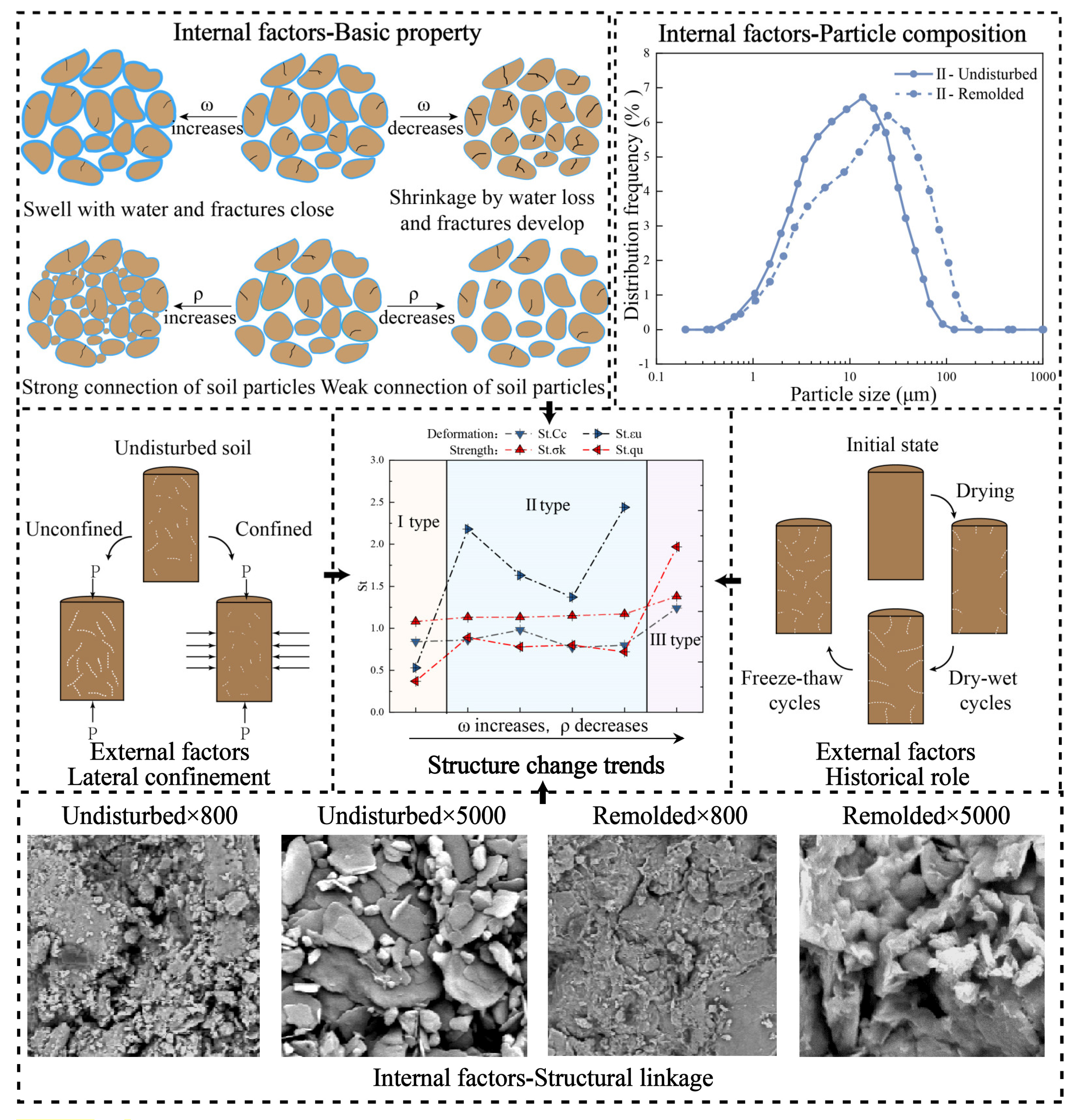
| Property | Values |
|---|---|
| Liquid limit /% | 41 |
| Plasticity limit /% | 24 |
| Plasticity index | 17.42 |
| Liquidity index | −0.13 |
| Free expansion rate /% | 76 |
| Optimum water content /% | 21.60 |
| Maximum dry density /(g/cm3) | 1.65 |
| Items | Depth/m | /% | /(g/cm3) | /(g/cm3) |
|---|---|---|---|---|
| 1-1 | 1 | 16.61 | 2.10 | 1.80 |
| 1-2 | 2 | 18.05 | 2.05 | 1.74 |
| 1-3 | 3 | 18.26 | 1.99 | 1.68 |
| 1-4 | 4 | 21.63 | 1.97 | 1.62 |
| 1-5 | 5 | 19.05 | 2.03 | 1.71 |
| 1-6 | 6 | 20.79 | 1.88 | 1.56 |
| 1-7 | 7 | 20.85 | 1.92 | 1.59 |
| 1-8 | 8 | 21.20 | 2.03 | 1.67 |
| 1-9 | 9 | 30.44 | 1.91 | 1.46 |
| 1-10 | 10 | 22.70 | 1.98 | 1.61 |
| 1-11 | 11 | 22.44 | 1.85 | 1.51 |
| 1-12 | 12 | 24.30 | 1.97 | 1.58 |
| 1-12 | 12 | 24.30 | 1.98 | 1.59 |
| 1-13 | 13 | 20.19 | 1.95 | 1.62 |
| 1-14 | 14 | 23.66 | 1.91 | 1.54 |
| Items | /% | /(g/cm3) | /(g/cm3) | Comparison | Type | |
|---|---|---|---|---|---|---|
| UCS tests | 1-1 | 16.61 | 2.10 | 1.80 | , | I |
| 1-4 | 21.63 | 1.97 | 1.62 | , | II | |
| 1-5 | 19.05 | 2.03 | 1.71 | , | II | |
| 1-8 | 21.20 | 2.03 | 1.67 | , | II | |
| 1-9 | 30.44 | 1.91 | 1.46 | , | III | |
| 1-14 | 23.66 | 1.91 | 1.54 | , | II | |
| High-pressure consolidation tests | 1-1 | 16.61 | 2.10 | 1.80 | , | I |
| 1-8 | 21.20 | 2.03 | 1.67 | , | II | |
| 1-9 | 30.44 | 1.91 | 1.46 | , | III | |
| 1-10 | 22.0 | 1.98 | 1.62 | , | II | |
| 1-12 | 24.30 | 1.97 | 1.58 | , | II | |
| 1-14 | 23.66 | 1.91 | 1.54 | , | II | |
| Items | Cc | Cs | Items | Cc | Cs |
|---|---|---|---|---|---|
| Undisturbed 1-1 | 0.216 | 0.0049 | Remolded 1-1 | 0.258 | 0.0052 |
| Undisturbed 1-4 | 0.197 | 0.0130 | Remolded 1-4 | 0.228 | 0.0090 |
| Undisturbed 1-5 | 0.212 | 0.0076 | Remolded 1-5 | 0.215 | 0.0061 |
| Undisturbed 1-8 | 0.140 | 0.0091 | Remolded 1-8 | 0.182 | 0.0110 |
| Undisturbed 1-9 | 0.132 | 0.0114 | Remolded 1-9 | 0.164 | 0.0203 |
| Undisturbed 1-14 | 0.257 | 0.0284 | Remolded 1-14 | 0.211 | 0.0252 |
Disclaimer/Publisher’s Note: The statements, opinions and data contained in all publications are solely those of the individual author(s) and contributor(s) and not of MDPI and/or the editor(s). MDPI and/or the editor(s) disclaim responsibility for any injury to people or property resulting from any ideas, methods, instructions or products referred to in the content. |
© 2024 by the authors. Licensee MDPI, Basel, Switzerland. This article is an open access article distributed under the terms and conditions of the Creative Commons Attribution (CC BY) license (https://creativecommons.org/licenses/by/4.0/).
Share and Cite
Sun, X.; Song, S.; Niu, C.; Zhang, X.; Dou, C.; Xia, W.; Li, X.; Wang, Q. Investigation of the Structural Strength of Expansive Soil in a Seasonally Frozen Region. Buildings 2024, 14, 789. https://doi.org/10.3390/buildings14030789
Sun X, Song S, Niu C, Zhang X, Dou C, Xia W, Li X, Wang Q. Investigation of the Structural Strength of Expansive Soil in a Seasonally Frozen Region. Buildings. 2024; 14(3):789. https://doi.org/10.3390/buildings14030789
Chicago/Turabian StyleSun, Xun, Shengyuan Song, Cencen Niu, Xudong Zhang, Chaoren Dou, Weitong Xia, Xinghua Li, and Qing Wang. 2024. "Investigation of the Structural Strength of Expansive Soil in a Seasonally Frozen Region" Buildings 14, no. 3: 789. https://doi.org/10.3390/buildings14030789
APA StyleSun, X., Song, S., Niu, C., Zhang, X., Dou, C., Xia, W., Li, X., & Wang, Q. (2024). Investigation of the Structural Strength of Expansive Soil in a Seasonally Frozen Region. Buildings, 14(3), 789. https://doi.org/10.3390/buildings14030789








